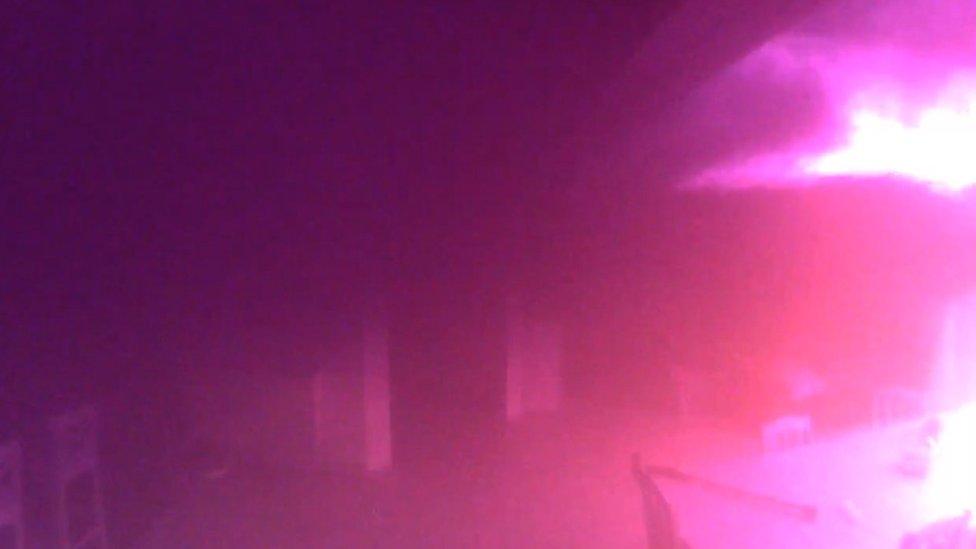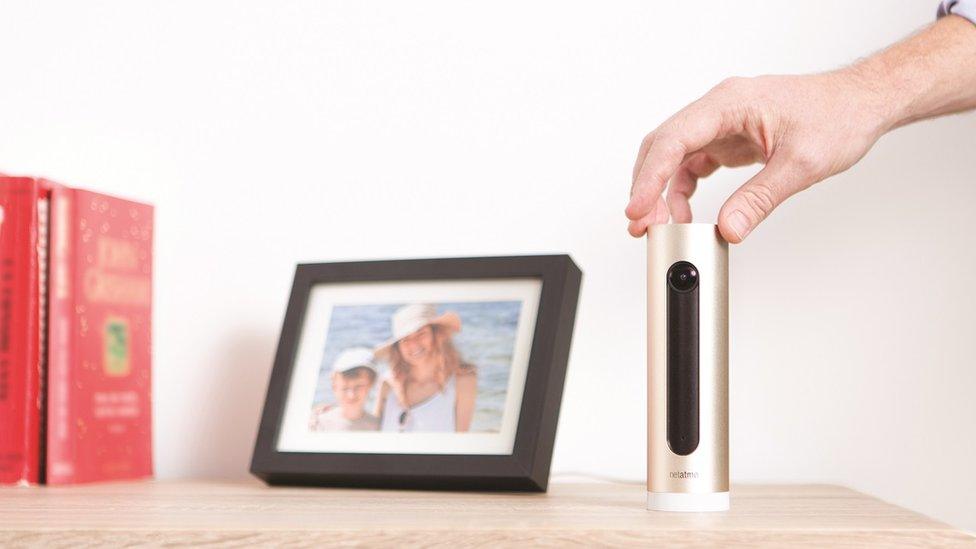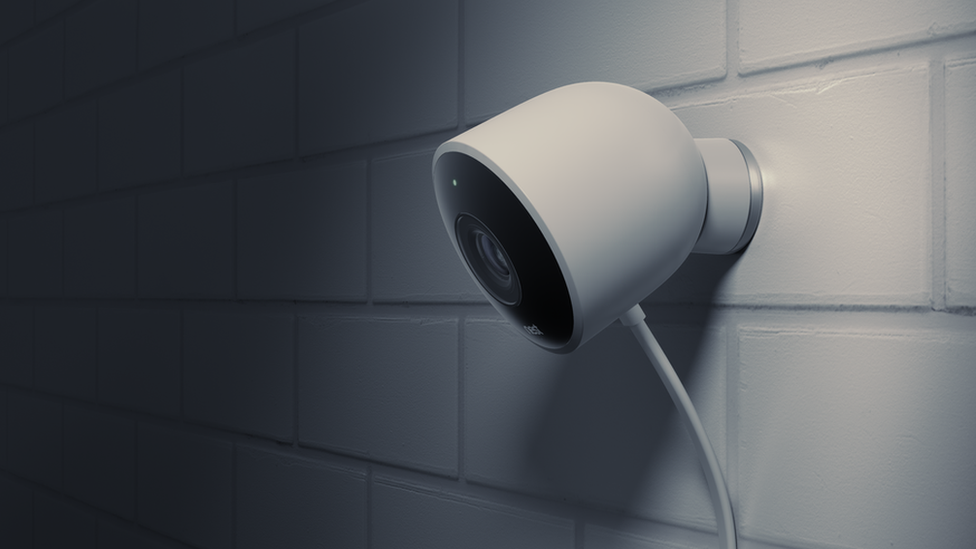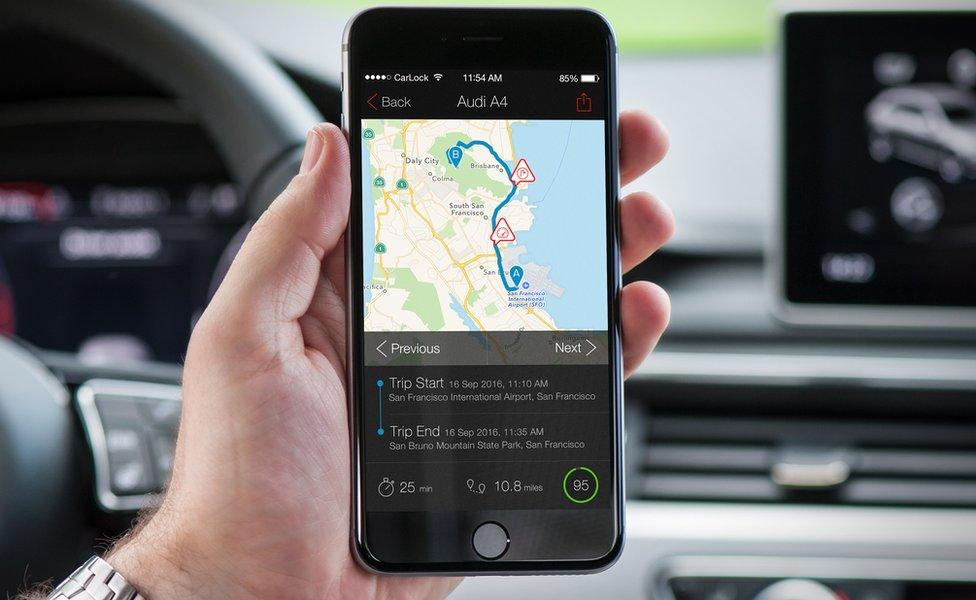How a family's dogs were saved from a fiery death
- Published

Lisbonne and Hawaii were saved from a house fire thanks to home security tech
Christophe Deschamps was watching a basketball game with his wife and three children when he received an alert on his smartphone.
The home security system told him something was wrong, so he quickly accessed the video feed on his phone.
"I could see smoke," he says. Their home, in the Wallonia region of southern Belgium, was on fire.
The family's thoughts immediately turned to their two Bernese Mountain dogs - Lisbonne and Hawaii - locked in the garage. A terrible family tragedy was threatening to unfold.
The video images now showed the smoke getting thicker and brightness coming from flames off-camera.
The fire alarm had already alerted the firefighters, so the Deschamps family rushed home as quickly as they could.
"It was more important for us to save the dogs than the house," says Christophe. "My wife was crying and panicking, thinking the dogs could die."

The security camera recorded the progress of the fire in the Deschamps' home
Fortunately, Lisbonne and Hawaii were saved with just 20cm of air left to breathe above the floor of the smoke-filled garage. But the fire damage to the house took six months to repair.
The dogs' lucky escape was due to the indoor security camera Christophe had installed.
The smart camera, made by Netatmo, sends alerts when it hears an alarm - whether smoke, carbon monoxide or security - and automatically starts recording.
It is also one of the first smart home cameras featuring face recognition technology capable of distinguishing between people it knows and strangers.
Parents working late can receive alerts when their kids arrive home, for example, and will receive an "unknown face seen" alert if someone breaks in.
The French company says evidence collected by its smart cameras has led to the successful prosecution of burglars.

Netatmo's video camera includes facial recognition capability
The connected home security market is expanding fast, with companies such as Withings, Nest, D-Link, Netgear, Philips, Panasonic - not to mention the tech behemoths Apple, Amazon and Samsung - all offering an expanding array of internet-connected smart gadgets, from thermostats to motion-sensitive cameras with infrared and audio capability.
"We put the connected home security market at 95.4 million unit sales in 2016," says Francesco Radicati, a technology specialist at consultancy Ovum.
"Service providers, such as Qivicon, AT&T Digital Life, and Vivint Smart Home, are selling device multi-packs including multiple sensors, and these are proving very popular.
"We estimate the market will grow to 744 million devices sold in 2021."
Innovations are coming on to the market thick and fast.
For example, connected light bulb firm LIFX has produced a version that can beam infrared light outdoors, enabling a compatible security camera, such as the Nest Cam Outdoor, to see better in the dark.
The key innovation, however, has been the integration of the smartphone into such connected networks, giving users remote control wherever they have an internet connection.

Google-owned Nest is developing a suite of connected home devices
But aren't all these security cameras intrusive and even a little voyeuristic?
Netatmo has addressed this issue by making its Welcome camera programmable, so you can disable recording for individuals you specify. And most camera systems can be disabled remotely.
It isn't just our homes that technology is helping keep safe.
Cars are also a common target for thieves. This is why Matej Persolja, 33, founded CarLock, a company based in Nova Gorica, Slovenia, and San Francisco in the US.
CarLock's system plugs into a vehicle's onboard diagnostics port and sends an alarm to your phone if your vehicle is moved, the engine starts, it detects unusual vibration, or if the gadget is disconnected.
Mr Persolja started the business after thinking his car had been stolen. It turned out his car had only been moved to make way for construction work taking place in the area.

CarLock can track your car's position
"Before I learned that, I was almost certain my car had been stolen and I still remember that awful feeling," he says.
The CarLock system enables owners to track the location of their car if it has been stolen and also acts like a telematics box recording driving behaviour and the general health of the engine.
And there are a growing number of remote control apps for cars on the market.
Viper's SmartStart app - currently only available in the US and Canada - enables you to start your car, lock and unlock it, and track its movements remotely using your smartphone.
Remote starting is useful for de-icing your car in the mornings while you get ready for work and have breakfast. Even if someone sees the car running and a thief smashes a window to steal it, the physical key is still needed to drive the car off.
You can also keep an eye on your kids' driving habits and receive an alert if they take the car beyond a geographical point that you specify.
Ford is even integrating Amazon's Alexa voice-activated software into its cars, enabling drivers to remotely start their cars with a voice command and personal identification number.
Of course, the elephant in the room with all these connected security products is the risk of being hacked. The UK's National Cyber Security Centre recently demonstrated how a connected doll could be hacked and used to open remote control door locks.
And poorly secured security cameras have been hijacked to carry out web attacks.
How to protect your smart home and all its internet-connected devices will be the subject of a future Technology of Business feature.
Follow Technology of Business editor Matthew Wall on Twitter, external and Facebook, external